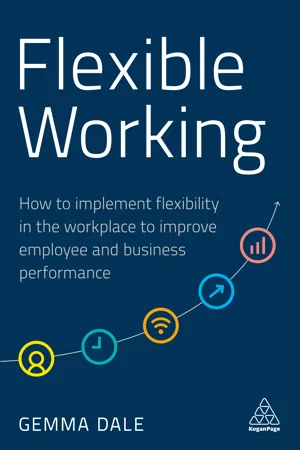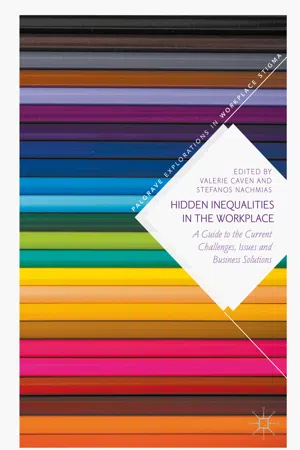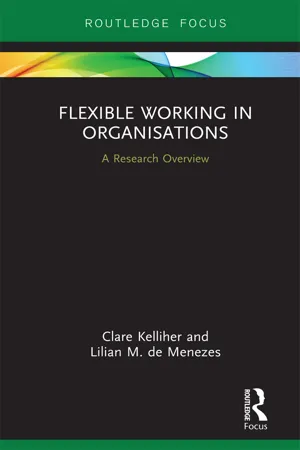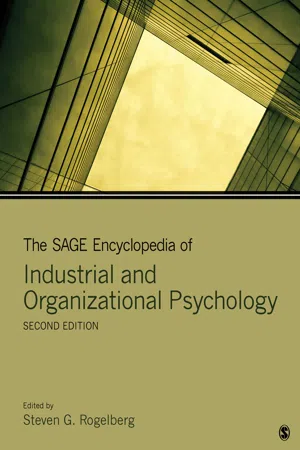Flexible Work Arrangements
Flexible work arrangements refer to non-traditional work schedules or locations that allow employees to have more control over when and where they work. This can include options such as remote work, flexible hours, compressed workweeks, or job sharing. These arrangements can help improve work-life balance, increase employee satisfaction, and attract and retain top talent.
6 Key excerpts on "Flexible Work Arrangements"
- eBook - ePub
Flexible Working
How to Implement Flexibility in the Workplace to Improve Employee and Business Performance
- Gemma Dale(Author)
- 2020(Publication Date)
- Kogan Page(Publisher)
...There are varying degrees of worker autonomy in relation to time flexibility, from complete employee control over when work is undertaken to systems with detailed constraint such as flexi-time combined with core hours. ‘Where’ work is undertaken (or location flexibility) has in particular been influenced by technology advances in recent years; many workers are now able to undertake their full range of duties anywhere with a wifi connection. Work can take place in the office, a home, a co-working space, a client’s premises, a train or a coffee shop. Workers have the potential to be increasingly untethered from a physical space – where of course the organizational culture permits. Finally, there is ‘how’ work is undertaken. This can be categorized again into methods for undertaking as well as ‘how much’ work is undertaken. On a practical level, flexible working arrangements can be both formal (agreed by way of the contract of employment, often via an organization’s internal policy or statutory process) or informal (agreed locally between an employee and their immediate line manager, on a regular or ad hoc basis). The approach taken in each case is very much related to the culture of the organization, and the extent to which flexible approaches to work are enabled and encouraged. There are many reasons why people work flexibly, and the drivers behind it can vary depending on the nature of the particular flexible working arrangement. The 2019 CIPD Working Lives survey looked into why people work flexibly. Surprisingly perhaps, and contrary to the stereotype of who personally wants to use flexible working, providing care for children or other relatives amounted to just under a quarter of reasons for those surveyed...
- eBook - ePub
Hidden Inequalities in the Workplace
A Guide to the Current Challenges, Issues and Business Solutions
- Valerie Caven, Stefanos Nachmias(Authors)
- 2017(Publication Date)
- Palgrave Macmillan(Publisher)
...However, the extent to which contemporary organisations are ready to fully embrace flexibility to accommodate employees’ often changeable preferences and negotiate new arrangements is under-researched. While improved job satisfaction (Wheatley in press) as the result of flexible working is reported in workplaces, a few studies nonetheless argue, in addition to administration, supervision and management cost ensued, greater flexibility runs counter to the effective control and rationalisations that contemporary organisations rely upon (Blyton 1985 ; Todd and Binns 2013). This at least provides part of the explanation behind the slow and uneven implementation of various flexible working arrangements. Employers’ resistance has also been manifested through unwritten rules against these new ways of working (Pleck 1993) as well as a lack of formal and transparent procedures of guiding employees to engage in such practices (Todd and Binns 2013). The findings in this chapter hold important implications for managers and HR practitioners. Perhaps the most obvious implication is that organisations offering flexible working arrangements must recognise and address ‘hidden’ inequalities and discriminations against those who use them and those whose requests are perceived unlikely to be granted and thus never attempted to ask. New policies aiming to enhance a more widespread take-up of flexible work schedules should recognise bias avoidance associated with flexibility requests and install effective bias control measures (Dobbin and Kelly 2007 ; Kelly and Kalev 2006) when flexibility policies are introduced; otherwise, their policies risk being under-used. Employers could take measures to ensure greater enforcement of equal opportunity laws that prohibit gender discrimination in accessing work facilities such as flexi-time, work at home, job sharing, reduced work hours and work in compressed hours...
- eBook - ePub
Flexible Working in Organisations
A Research Overview
- Clare Kelliher, Lilian M. de Menezes(Authors)
- 2019(Publication Date)
- Routledge(Publisher)
...Their inferences, based on a large database that included 16,000 plants in Germany from 2007 to 2011, showed that firms that adopted the two types of flexible working arrangements tended to report innovative activity in terms of product or process innovation. These results were found to hold even when the two types of arrangements were combined. As a result, the authors concluded that the positive association with innovation stems from the amount of control and self-management over working days that is transferred to employees. Peretz, Fried and Levi (2018) developed a multi-level analysis of data from 4790 organisations in 21 countries extracted from the 2009 to 2010 CRANET survey, including companies that reported data on flexible working arrangements (flexitime, job sharing, compressed work week and telework), cultural practices (GLOBE national values) and had at least 80% of their workforce classified as full-time. They observed that national cultural values and organisational characteristics were related to performance outcomes, via the use of flexible working arrangements. In addition, the use of flexible working arrangements reduced absenteeism and turnover, but this reduction was weakened when the flexible working arrangements were not consistent with the local cultural values. The authors concluded that a misfit between national culture and flexible working arrangements could reduce uptake of flexible working by employees and consequently increase the likelihood of absenteeism and turnover...
- eBook - ePub
Smart Flexibility
Moving Smart and Flexible Working from Theory to Practice
- Andy Lake(Author)
- 2016(Publication Date)
- Routledge(Publisher)
...We prefer informal arrangements rather than over-engineered policies or a bureaucratic approach. Working from home can be a great way to avoid lengthy commutes and maximises your time and personal effectiveness so you can keep those commitments outside work. And our arrangements are not just for parents, – we know everyone has commitments in their life outside work, so we also encourage people to undertake volunteering or participate in sporting and other social activities. Helping employees achieve a good work-life balance remains a key aim for Britvic. As people have to travel to work within the congested South East of England, physical meetings are typically scheduled between 10 a.m. and 4 p.m. to allow leeway for travel and other responsibilities. Meanwhile, the focus remains on getting the job done, wherever and whenever is best for the individual and compatible with team arrangements. Sue sums up their approach: Flexible working is absolutely critical for the modern business. It’s the way to attract and retain the best people. We’ve tried hard to get the balance right between the needs of the business and the needs of individual employees, and to create a physical centre for collaboration which is the heart of the company. We’re delighted that our approach to flexibility has meant that we’re able to retain so many of our employees during this relocation. We absolutely believe that creating such an inspiring and collaborative workspace will further enhance team-working, strengthen relationships and improve overall effectiveness. In the Future, Flexible Work = Work I remember hearing a paper at a European conference on ‘ework’. The speaker was saying that previously in European circles ework had been referred to as ‘telework’. So we had progress, he said. We’d lost the first three letters from the word, now we just had to lose the ‘e’. Telework, or ework, would have come of age when we no longer talk about it...
- eBook - ePub
Public Personnel Management
Current Concerns, Future Challenges
- Norma M. Riccucci, Norma M. Riccucci(Authors)
- 2017(Publication Date)
- Routledge(Publisher)
...Environmental concerns continued to draw attention to options of moving work to people instead of people to work. For example, in 1990 revisions to the Clear Air Act required states to develop plans to reduce air pollution, including regulating emissions from motor vehicles, which the development of telecommuting options would address (Goluboff, 2001). Technological advances, especially the introduction of the home personal computer (PC) and increased Internet access and connectivity speeds, made telecommuting and telework more viable options. In addition, shifts from a manufacturing to an information economy increased the number of jobs appropriate for alternative work arrangements (Kizza, 2013). The Society for Human Resource Management (SHRM) performs an annual survey of a random sample of 24,000 of its approximately 275,000 members who work for firms of various sizes. SHRM 2016 survey results found that 3 out of 5 organizations offer some form of telecommuting benefits, up 40 percent from the 1996 level, with an 11 percent increase in the use of ad-hoc telecommuting over the last five years (Society for Human Resource Management, 2016). Comparatively, other areas of flexible working benefits saw minimal or negative growth; for example, flextime was up to 54 percent in 2016 (from 50 percent in 1996); compressed workweek increased to 29 percent from 23 percent; and job sharing had decreased from 24 percent use in 1996 to 10 percent in 2016. WorldatWork reports that remote work options remain the number one choice for organizations implementing workplace flexibility policies and programs. They find 85 percent of organizations use telework use on an ad-hoc basis (Worldatwork, 2015). Scholarship has examined what types of workers have access to flexible arrangements (Eldridge and Nisar, 2006; Golden, 2012; Liechty and Anderson, 2007; Pini and McDonald, 2008)...
- Steven G. Rogelberg(Author)
- 2016(Publication Date)
- SAGE Publications, Inc(Publisher)
...Flexible Work Schedules Flexible Work Schedules Boris B. Baltes Boris B. Baltes Baltes, Boris B. Daniel R. Krenn Daniel R. Krenn Krenn, Daniel R. 501 504 Flexible Work Schedules Boris B. Baltes Daniel R. Krenn A flexible work schedule, also known as a flextime schedule, grants employees some freedom in deciding what time of day they will arrive at and leave from work. For example, an employee may prefer to work from 7:00 a.m. to 3:00 p.m. one day of the week and from 10:00 a.m. to 6:00 p.m. on another day. The exact administrative rules of flextime schedules vary greatly across companies, but when flextime schedules are put into place, employers usually create a band of core time during which each employee must be present (normally 9:00 or 10:00 a.m. to 2:00 or 3:00 p.m.). For example, a flexible work schedule in which all employees must be present from 10:00 a.m. to 3:00 p.m. would have 5 core hours. Employees are free to arrive before the core start time and leave after the core finish time, but typically, there is a limit as to how early employees can arrive and how late they can stay. For example, an employer may dictate that employees cannot start before 7:00 a.m. and cannot stay past 9:00 p.m. Another important characteristic that may vary widely among flexible work schedule arrangements concerns the degree of carryover...





